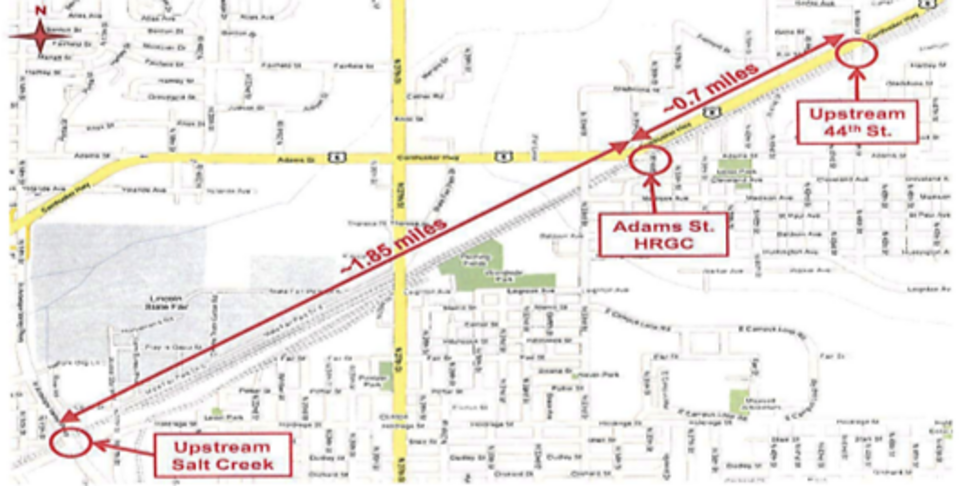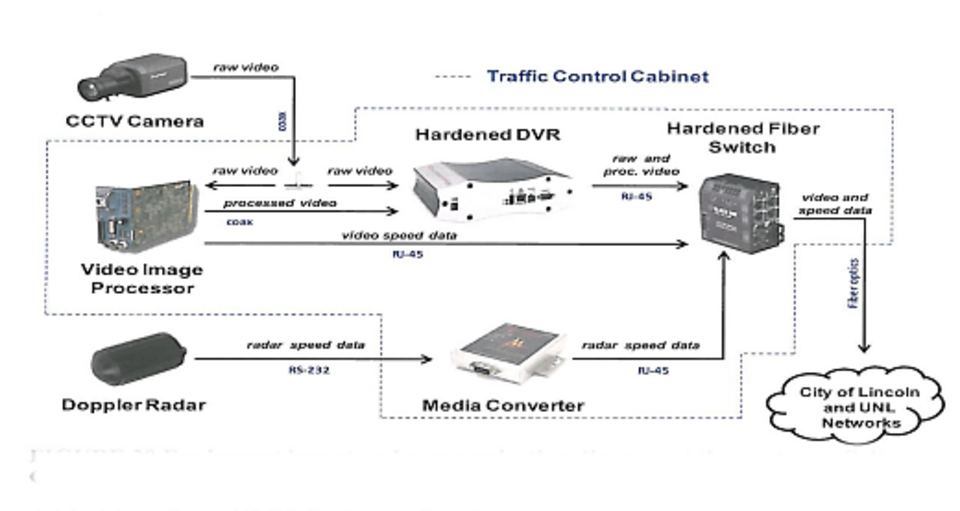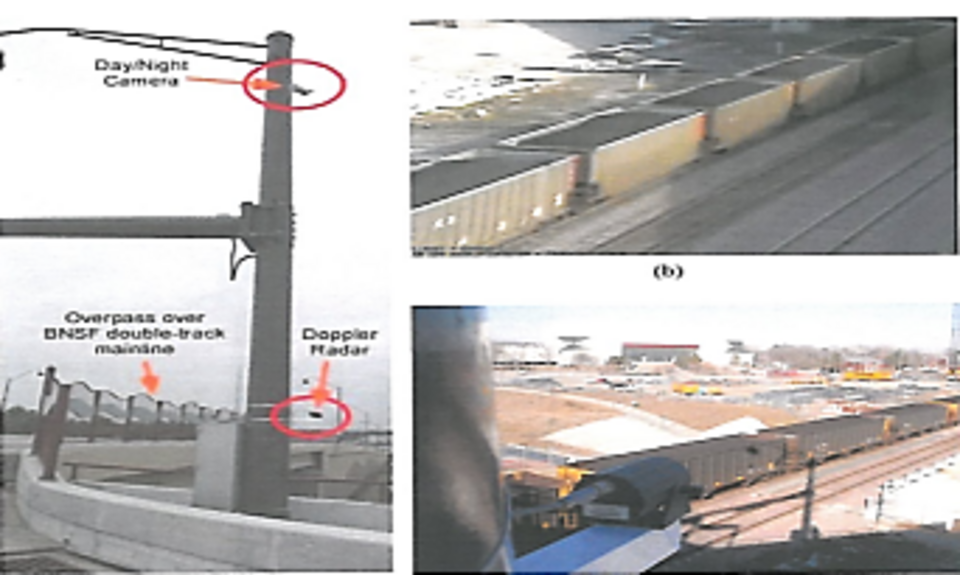Instrumented High Speed Intersection Test Bed Facility
Wavetronix LLC with Dr. Anuj Sharma of the University of Nebraska-Lincoln’s Nebraska Transportation Center developed a prototype "Safe Track Protection and Advance Warning System" sensor for improving safety and efficiency at high-speed isolated signalized traffic intersections. Wavetronix LLC had received a Small Business Innovation Research (SBIR) grant from the Department of Transportation to develop such a system. Two state-of-the art test beds placed in Utah and Lincoln, Nebraska were deployed as a part of this project. These are the only test beds in the United States with the ability to track vehicles over a range of 1,000 ft
The sites consist of three Digital Wave Radar sensors used for tracking vehicles over a range of 1,000 ft. Two pan-tilt-zoom (PTZ) video cameras are the integral part of the system for ground truthing and sensor fusion enhancement.

The following guidelines pertain to the Nebraska site selection:
The intersection approach has the following characteristics:
- Signalized traffic control without AWS flashers
- A posted speed limit of 55 mph
- Two through lanes
- Minimum roadside clutter
- Median between directions of travel
The Collection system has been designed with the following power/communication options:
- A fiber and power homerun connection from the sensor pole to the traffic cabinet provides aC power and RS=485 communcation. The small cabinet on the pole can communicate with the traffic control cabinet over this fiber line.
The sensor pole has the following characteristics:
- The pole is located approximately 500 feet from the stop line.
- The pole is offset about 15 feet from first lane
- Three sensors (each about 5lbs), two PTZ video cameras and one small cabinet (less than 14 cubic inches) near the base are mounted on the pole. A side-fire sensor is mounted about 20 feet and forward, and reverse-fire sensors are mounted higher (about 25 feet). The pole cabinet currently holds a computer for data collection.
The main traffic cabinet consists of these additional components:
- A small microcontroller communicates with the pole cabinet and also acts as a time server
- The phase information is captured using clamp-on transformers on the load switch wires going to the signal head
Coordinated Arterial Test Sites
The coordinated approaches of intersections at i) 17th and G streets and ii) Cornhusker Highway and 27th Street in Lincoln, Neb., have been instrumented using multiple sensors.
For wide area detection, the Wavetronix SmartSensor Advance is being used. The SmartSensor Advance has a detection range of 500 feet and is installed on the traffic signal mast arm at both locations.
The Sensys Wireless Vehicle Detection System is being used for the stop bar and advance detectors. The Sensys Wireless Detection System has four components: flush-mount wireless sensors, a repeater, an access point, and contact closure cards. Three wireless sensors, which include one stop bar detector and two advance detectors, are needed per lane. A repeater is needed to relay the advance detector information to the access point, which transfers the data to the contact closure card located inside the traffic cabinet. The access point also relays the stop bar detectors' information to the contact closure card. The pictures below show the relative locations of each hardware component in the field at 17th and G streets.
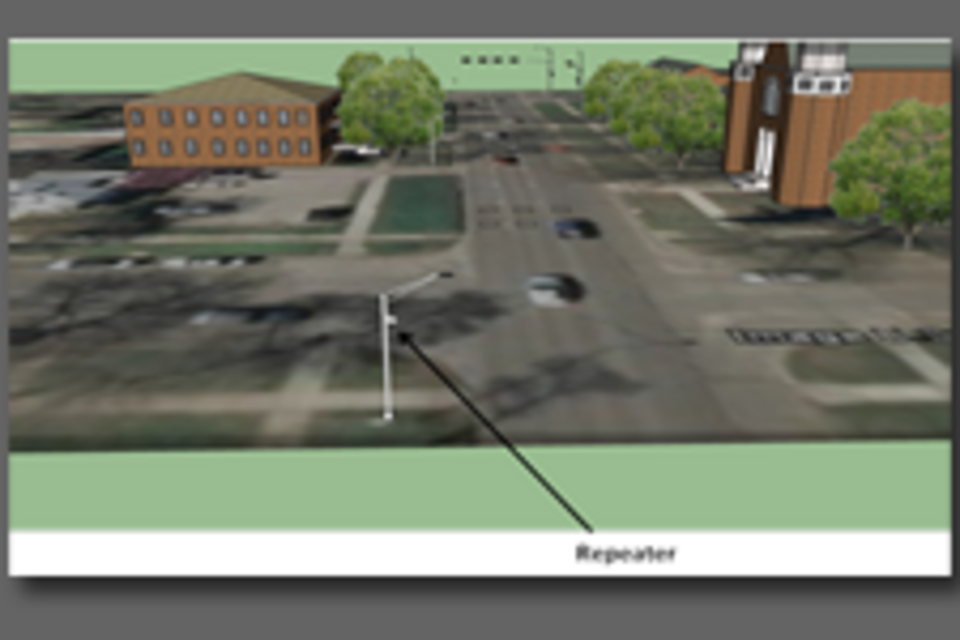

3D Image of Access Point, Wavetronix, and Video Camera
The photo below shows data collection capability at 17th and G streets in Lincoln, Neb. This is an extensively instrumented intersection with the capability of collecting detector actuations, signal states, wide area vehicle tracking and simultaneous video recording of the existing traffic condition. SCADA software by Wonderware is being used for data collection. Each intersection has digital I/O devices collecting the phase information and detection actuations as well as an IP-based PTZ camera communicating with a central server hosted in the Lincoln Department of Public Works. The SCADA software’s human machine interface provides a capability of overlaying the video with the detector and phase status. This can be recorded and later used for performing the ground truthing. The historian of the SCADA system time stamps and records all the detection and phase actuations. Also, Longwatch software can be used to record video and tag it with any anomalies observed in detector status. The instrumented intersection at 27th Street and Cornhusker Highway has similar capabilities
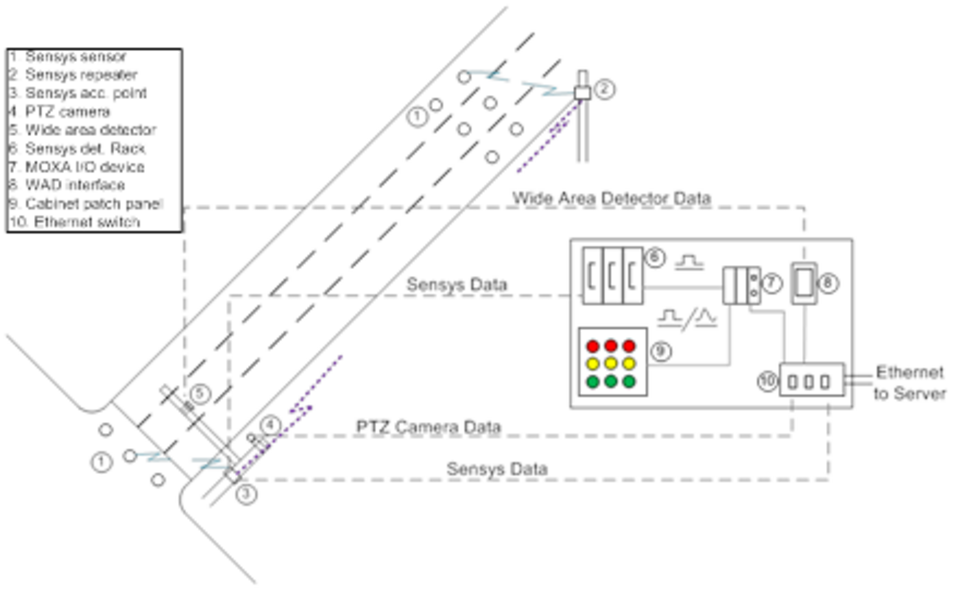
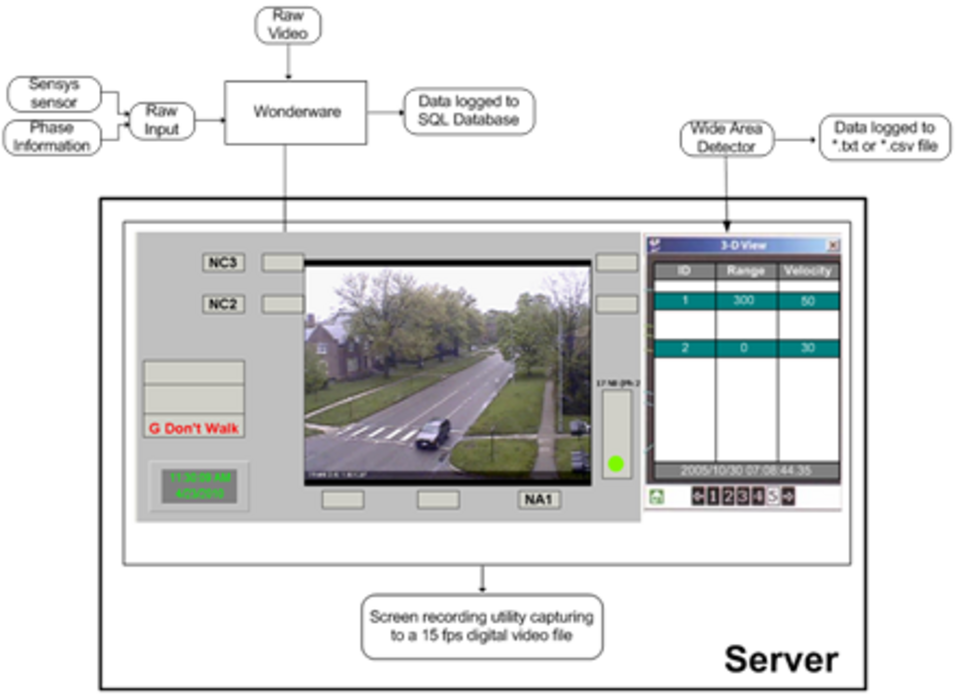
Hybrid Energy Test Bed
The project titled "A Roadway Wind/Solar Hybrid Power Generation and Distribution System: Towards Energy-Plus Roadways" is funded by the Exploratory Advance Research program of the Federal Highway Administration.
The project has generated a lot of local and national interest. A one-of-its-kind test bed in the United States has been installed at 84th Street and Highway 2 (shown at right). The test bed will be used to build models for energy resource estimation, prediction and power consumption at a signalized traffic intersection. Dr. Sharma is currently building a driving simulator to evaluate the impacts of the wind generator on driver behavior. These test beds are used to integrate research with graduate and undergraduate education. State-of-the-art test beds are indispensable resources to provide "hands-on" experience to the students.

Instrumented Highway-Rail Grade Crossing
Each year, numerous crashes involving severe injuries are reported at highway-rail grade crossings across the United States. While published literature on highway-rail grade crossing safety is relatively sparse compared to the safety of highway segments or intersections, crashes at highway-rail grade crossings are invariably the result of errors committed by highway users. There is a significant need to monitor the behavior of motorists, pedestrians, and bicyclists at highway-rail grade crossings on a long-term basis. Also, there is a need to test various countermeasures that can enhance safety.
Researchers at the Nebraska Transportation Center have studied the grade crossing at N. 141st St. in Waverly, Neb., on a limited basis for assessment of safety and countermeasure evaluation (shown at right). This grade crossing is in the vicinity of a major state highway and close proximity to an operating traffic signal. The geometry and roadway traffic characteristics are unique, resulting in significant potential for understanding the interactions between roadway and train traffic.
Establishment of this grade crossing as a permanent test bed will give the researchers opportunities to study user behavior as well as conduct countermeasure evaluations. Needs for test bed setup include installation of day- and night-vision cameras on both sides of the crossing as well as setup of wireless communications with the Transportation Operations Laboratory.
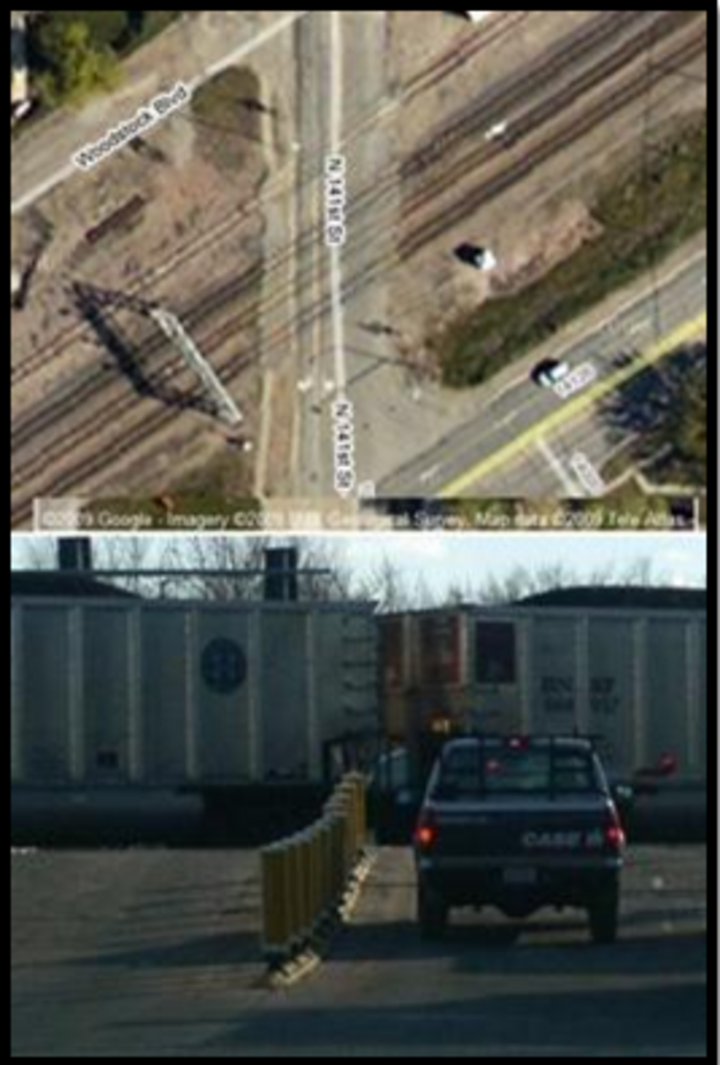
Roundabout Test Bed Facility
Construction of roundabouts in place of traditional four-legged intersections is becoming increasingly common in the United States. These were adopted in the early 1990s from Europe and Australia, where they are more common. The roundabout is a circular intersection with channelized approaches requiring entering drivers to yield to traffic in the circle and allowing for continuous traffic flow through the intersection at speeds less than 30 mph. Roundabouts provide operational and safety benefits and are increasingly recommended as part of new construction or retrofitting of existing intersections. Roundabouts have been constructed in Nebraska starting with the first roundabout along a major urban arterial in 2002 at the intersection of 33rd Street and Sheridan Boulevard in Lincoln. Transportation agencies in Nebraska plan on constructing additional roundabouts across the state in the near future. While some research pertaining to operational characteristics of roundabouts exists in published literature, issues related to driver behavior and accommodation of bicyclists/pedestrians are less understood. Acquisition of such information and a better understanding of user needs is in the interest of enhanced public safety. Additionally, there is a need for a permanent roundabout test bed that can provide a steady stream of data on roundabout user behavior. The establishment of a roundabout test bed that allows researchers at the Nebraska Transportation Center to study a variety of roundabout issues such as safety, user behavior, and traffic operations will be invaluable.
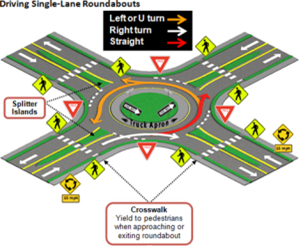
The city of Lincoln has replaced the four-legged intersection at 14th and Superior streets with a roundabout. It was proposed that a roundabout test bed be established at this location that allows monitoring of traffic before and after construction of the roundabout. Establishment of the proposed roundabout test bed will benefit public safety and help with more efficient traffic operations.
Mobile Driver Stress and Traffic Conditions Monitoring
Dr. Sharma has also been exploring the innovative idea of using driver anxiety as a measure of performance of the transportation system. His research has been supported from both internal funding and Mid-America Transportation Center funding. For successful investigation in this area, he has partnered with the University of Nebraska Medical Center, University of Nebraska Omaha, the truck driving training program at Central Community College in Hastings, Neb., and Werner Enterprises. A prototype onboard driver stress and traffic flow information monitoring system was developed during the course of this research.
The monitoring system consists of:
- An integrated GPS and inertial measurement unit to monitor vehicle position, velocity, and acceleration.
- BioPac MP150 for measuring driver's ECG and galvanic skin conductance.
- Prosilica camera to monitor the road conditions.
- Logisys truck PC to time stamp and log all the information.
A software program was developed to time stamp and record information coming from multiple streams. Dr. Sharma is currently using this system to measure driver stress under varying driving conditions.
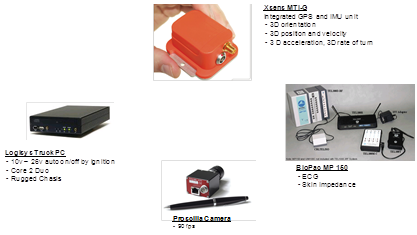
Highway Rail Grade-Crossing Test Bed
UNL has recently established a test bed in Lincoln, Neb. The purpose of the test bed is to provide a platform to investigate ITS applications with respect to highway traffic operations near the railway intersection. Traffic signal preemption and train arrival information are some of the applications that can be investigated by the test bed system. The test bed is capable of collecting data on train speeds in a multiple-track environment. The equipment used is a day/night camera, Doppler radar sensor, video processor, hardened DVR, media converter, and hardened switch. The research conducted at the test bed evaluates the performance of video image detection and Doppler radar, which detect train speeds in a multi-track environment and the interaction with the intersections and train signaling.
